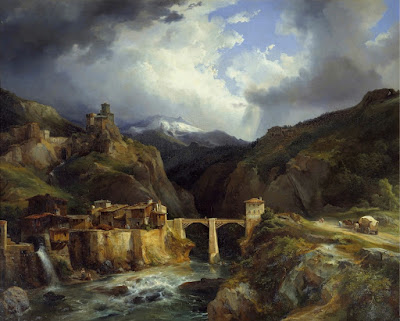 |
| Palma il Vecchio Young Faun with Pipes ca. 1513-15 oil on panel Alte Pinakothek, Munich |
 |
| Anonymous Italian Artist Rest on the Flight into Egypt ca. 1520 oil on canvas Bonnefantenmuseum, Maastricht |
 |
| Girolamo Muziano Landscape with St Jerome before 1592 drawing Musée du Louvre |
 |
| Orazio Gentileschi St Christopher carrying the Christ Child ca. 1610-12 oil on copper Gemäldegalerie, Berlin |
 |
| Pietro Testa Landscape with Boats on a River before 1650 drawing Musée du Louvre |
 |
| Herman van Swanevelt Rocky Landscape with The Good Samaritan before 1655 drawing Musée du Louvre |
 |
| Anonymous Flemish Artist Monk praying in a Landscape 17th century drawing Musée du Louvre |
 |
| Anonymous Flemish Artist Landscape with Hunters 17th century drawing Musée du Louvre |
 |
| Hubert Robert Artist drawing Ancient Fragments in the Farnese Gardens with a Distant View of Rome ca. 1763-64 drawing Musée du Louvre |
 |
| Jean-Pierre Hoüel Fountain of Arethusa, Syracuse ca. 1776 gouache on paper Musée du Louvre |
 |
| Egbert van Drielst Farms on the Fringe of a Wood 1812 oil on panel Rijksmuseum, Amsterdam |
 |
| Jean-Charles-Joseph Rémond Village and Bridge of Crevola on the Road from Simplon to Domodossola 1832 oil on canvas Musée d'Arts de Nantes |
 |
| David Cox A Windy Day 1850 oil on canvas Tate Britain |
 |
| George Adolphus Storey Contemplation 1859 oil on canvas Museums Sheffield, Yorkshire |
 |
| Edvard Munch Bay with Boat and House 1881 oil on cardboard Museo Thyssen-Bornemisza, Madrid |
 |
| Camille Pissarro Hill near Auvers 1882 oil on canvas Museum Boijmans Van Beuningen, Rotterdam |
"Let us now see how far it is possible to allegorize with landscape. Allegorical paintings are those which present perceptible objects in the picture under such conditions as we are not accustomed to see such objects in everyday life or in the story or fable presented in the picture itself. This strange relationship between perceptible objects and their presentation in the picture under circumstances different from more usual ones is precisely what alerts us to the hidden meaning that is the basis of allegory and the key to its interpretation. How then is it possible in a landscape to transform the visible and familiar conditions of objects into one so strange that we tell ourselves: this is allegory? One could of course locate the earth at the top and the sky below, one could paint pastry on the trees in place of foliage, etc. But this would simply destroy nature itself. . . . It is undeniable: he who would deviate from nature, as we generally see her every day, in the domain of landscape either creates the impression of an erroneous imitation or that of some alien scene in a distant and remote part of the world, and the latter in turn also involves expression. One will therefore never be able to allegorize with any properly composed landscape. It is quite true that the figures in such a landscape could express an allegorical event. But if they are subordinated to the landscape itself, they remain a secondary feature, a symbol or attribute of the latter. If they are the principal subject on the other hand, the landscape merely presents the scene for the event and belongs in the expressive domain of history painting. . . . "
– Friedrich Ramdohr, from Remarks upon a Landscape Painting intended as an Altarpiece by Herr Friedrich in Dresden, and upon Landscape Painting, Allegory and Mysticism in General (1809), translated by Nicholas Walker (2000)